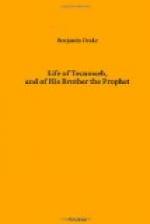As the claim of colonel Johnson to the honor of having killed Tecumseh, has been recently and earnestly urged upon the public consideration, we propose, even at the risk of some repetition, to examine in detail the testimony which bears upon this point.
It will be recollected that the Potawatamie chief, whose narrative is quoted from the “History of the Indian Tribes of North America,” testifies that Tecumseh met his death by a wound above or in the eyes; and, that upon his fall the Indians ran. If these statements be true, Tecumseh could not have been killed by colonel Johnson, as will be satisfactorily established in the course of this examination.
Shawbeneh, another Potawatamie chief, states that Tecumseh was mortally wounded in the neck, before he rushed upon the individual who killed him. All the other witnesses, except one, say that Tecumseh remained stationary, and that the horseman who fired the fatal shot, advanced upon him.
Chamblee, the third Potawatamie who testifies in the case, states that Tecumseh was engaged in a personal conflict with a soldier armed with a musket, when a horseman, on a spotted horse, rode up and shot him dead with a pistol. This account is not sustained by any other witness.
Captain M’Affee, who belonged to the mounted regiment, and who has written a history of the late war, says, it is generally believed that Tecumseh fell by the hand of colonel Johnson; but the historian candidly admits that there was another dead Indian at the spot where Tecumseh lay, and that Mr. King, of captain Davidson’s company, killed one of them. It May be questioned whether there is or ever has been any general belief,—whatever vague reports may have been circulated,—that colonel Johnson killed this chief; but even if such were the case, it does not by any means establish the allegation.
Brown, another historian of the late war, says, in general terms, that Tecumseh advanced upon the colonel with a sword or tomahawk, and that the colonel shot him dead. Tecumseh wore no sword in that action, nor did he advance upon colonel Johnson. Mr. Brown cites no authorities for his loose and general statements.




